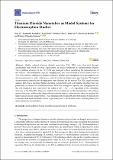| dc.contributor.author | Li, Xian | |
| dc.contributor.author | Pustulka, Samantha | |
| dc.contributor.author | Pedu, Scott | |
| dc.contributor.author | Xue, Yuan | |
| dc.contributor.author | Richter, Christiaan | |
| dc.contributor.author | Taboada-Serrano, Patricia | |
| dc.contributor.author | Close, Thomas Charles | |
| dc.date.accessioned | 2018-06-26T14:54:03Z | |
| dc.date.available | 2018-06-26T14:54:03Z | |
| dc.date.issued | 2018-06 | |
| dc.date.submitted | 2018-04 | |
| dc.identifier.issn | 2079-4991 | |
| dc.identifier.uri | http://hdl.handle.net/1721.1/116618 | |
| dc.description.abstract | Highly ordered titanium dioxide nanotubes (TiO<sub>2</sub> NTs) were fabricated through anodization and tested for their applicability as model electrodes in electrosorption studies. The crystalline structure of the TiO<sub>2</sub> NTs was changed without modifying the nanostructure of the surface. Electrosorption capacity, charging rate, and electrochemical active surface area of TiO<sub>2</sub> NTs with two different crystalline structures, anatase and amorphous, were investigated via chronoamperometry, cyclic voltammetry, and electrochemical impedance spectroscopy. The highest electrosorption capacities and charging rates were obtained for the anatase TiO<sub>2</sub> NTs, largely because anatase TiO<sub>2</sub> has a reported higher electrical conductivity and a crystalline structure that can potentially accommodate small ions within. Both electrosorption capacity and charging rate for the ions studied in this work follow the order of Cs<sup>+</sup> > Na<sup>+</sup> > Li<sup>+</sup>, regardless of the crystalline structure of the TiO<sub>2</sub> NTs. This order reflects the increasing size of the hydrated ion radii of these monovalent ions. Additionally, larger effective electrochemical active surface areas are required for larger ions and lower conductivities. These findings point towards the fact that smaller hydrated-ions experience less steric hindrance and a larger comparative electrostatic force, enabling them to be more effectively electrosorbed. | en_US |
| dc.publisher | Multidisciplinary Digital Publishing Institute | en_US |
| dc.relation.isversionof | http://dx.doi.org/10.3390/nano8060404 | en_US |
| dc.rights | Creative Commons Attribution | en_US |
| dc.source | Multidisciplinary Digital Publishing Institute | en_US |
| dc.title | Titanium Dioxide Nanotubes as Model Systems for Electrosorption Studies | en_US |
| dc.type | Article | en_US |
| dc.identifier.citation | LI, Xian, Samantha Pustulka, Scott Pedu, Thomas Close, Yuan Xue, Christiaan Richter and Patricia Taboada-Serrano. "Titanium Dioxide Nanotubes as Model Systems for Electrosorption Studies." Nanomaterials, 2018, 8(6), 404. | en_US |
| dc.contributor.mitauthor | Close, Thomas Charles | |
| dc.relation.journal | Nanomaterials | en_US |
| dc.eprint.version | Final published version | en_US |
| dc.type.uri | http://purl.org/eprint/type/JournalArticle | en_US |
| eprint.status | http://purl.org/eprint/status/PeerReviewed | en_US |
| dc.date.updated | 2018-06-25T07:43:09Z | |
| dspace.orderedauthors | Li, Xian; Pustulka, Samantha; Pedu, Scott; Close, Thomas; Xue, Yuan; Richter, Christiaan; Taboada-Serrano, Patricia | en_US |
| dspace.embargo.terms | N | en_US |
| mit.license | PUBLISHER_CC | en_US |
